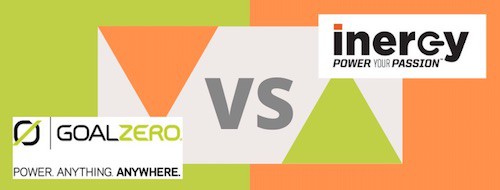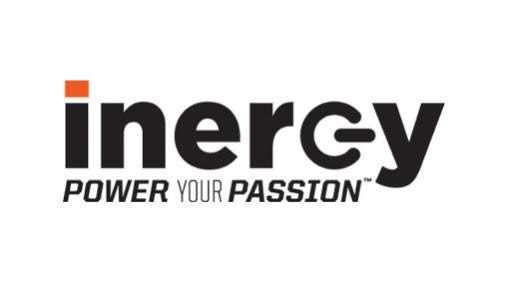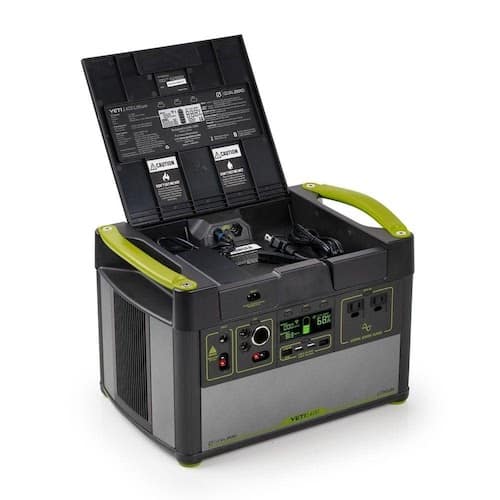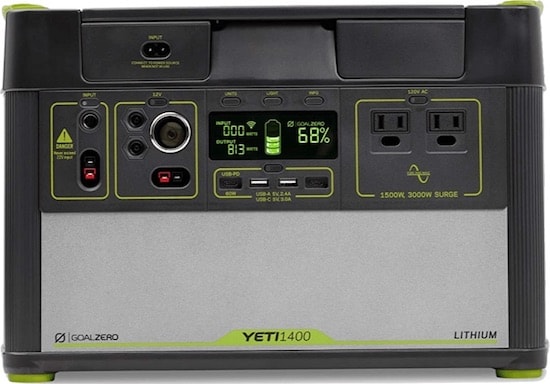In this article, we will be comparing Goal Zero and Inergy.
Both Goal Zero and Inergy have a number of solar generators to choose from.
For Goal Zero, we have the Yeti 1250 and Yeti 1400 Lithium, amongst several others. Overall, Goal Zero is easily one of the most sought-after and reliable solar power stations on the market.
Inergy somewhat follows suit. Over the years, their solar power stations have proven to be excellent alternatives to other counterparts in the market.
This brand champions the manufacture of lightweight designs with advanced features.
In a comparison of Goal Zero vs Inergy, it is important to note they are very different companies. Goal Zero makes several off-grid products and has a wide range of solar generator models. Inergy makes solar generators and solar panels specifically and has only three models of solar generators.
Goal Zero vs. Inergy – Company Overview
Inergy has introduced three types of solar generators into the market, with the first two models having similar features and specs. However, there is an upgraded model manufactured by this company and it’s called the Flex. In this comparison, particularly in the products section, we will explore the product features, specifications, and so on for the Apex solar generator, which came out in 2019. The Apex is a strong competitor to the Goal Zero Yeti 1400.
Inergy and Goal Zero are both reliable and trusted solar generator companies. And although both brands have a variety of products with varying specialties and features, we will base this article more specifically on two of their most debated models—the Goal Zero Yeti 1400 and Inergy Apex. Conveniently, we can also classify both models in the medium-large range in terms of battery capabilities.
In this article, our comparison will be generally divided into two categories, namely a comparison of the products and a comparison of the companies’ missions & values.
Product Comparisons

With several solar power stations now existing in this segment, we have logically resorted to comparing popular products from both brands, i.e., Inergy Apex vs Goal Zero Yeti 1400 because they have a lot of user-experience and are very similar in size to each other. Nonetheless, you can be sure that you will leave with a detailed view of both brands as a whole as well.
We are basing our product comparison on the following factors:
- Look & feel
- Connector type
- Power and output
- Charging outlets
- Compatible solar charger
- Unique and special features
Goal Zero Yeti 1400
Inergy Apex
Look and Feel
It’s safe to say that the 1400 and Apex are completely different products from a design standpoint. From the images above, we can see that the Inergy power station takes a lean and rectangular form, while Goal Zero has more depth to it and has rounded sides.
Goal Zero’s 1400 model measures to 10.1” x 15.3” x 10.4”, while Inergy’s Apex measures 14” x 8” x 7”. This shows us that the Apex is a good amount smaller than the Yeti 1400. Moreover, weighing both products reveals that the Apex is much lighter and more portable.
While the Apex weighs just 25 lbs., the Yeti 1400 weighs 43.7 lbs. Both of these products are made with strong outer shells, durable handles for mobility, and LCD screens for ease of use.
Color-wise, the Goal Zero features a blend of green, grey, and silver. Inergy, on the contrary, features a black paint coat, plus some white and orange touches. The graphic on the Apex is a circuit board cut out in the shape of a mountain. This is referring to the Inergy Apex as being the company’s “peak” solar generator.
Similar: Inergy Apex vs Goal Zero Yeti 1000 – Which Ranks #1?
Connector Types
Inergy
The Inergy Apex uses an EC8 connector—so far, we haven’t seen any other brand or system make use of it. Rated to 50 amps, this solar generator doesn’t have any heating issues due to its ability to handle high amounts of current.
According to Inergy’s FAQ page on the Apex, “EC8 connectors are compact, require no tools to disconnect, are rated to handle 6 times the current demanded by the maximum charge input and are simply the safest connector available. EC8 connectors are keyed to prevent misalignment and are engineered to reduce excess heat.”
Before now, there were no EC8 to MC4 adapters. However, several users wanted to use their own panels instead of needing to purchase Inergy’s panels. This caused Inergy to produce the EC8 to MC4 adapter. If you’re new to solar panels, the MC4 connector is very common among solar panel manufacturers. The EC8 to MC4 adapter comes in both one-foot and 30-foot sizes.
At the release of the Inergy Apex, users were placed in a situation where they had to choose between two types of solar panels from Inergy – the semi-flexible Linx panels or the rigid Solar Storm panels. This came with a downside because the Inergy EC8 connectors on the solar panels that users purchased were not waterproof.
This posed great threats to durability, especially during harsh weather conditions and rainy seasons across the globe, and was obviously a significant setback to Inergy’s connection scheme. The main solution to this would be to put heat-shrink over the connections or use a product like the Twist and Seal for a similar effect.
After this commotion amongst the Inergy community, it is refreshing to note that over time, Inergy was able to beat the constraints of only having their users be able to use their own panels. Even though the panels’ connectors are not waterproof (EC8 or EC8 to MC4), they can be made waterproof via the methods mentioned earlier.
Goal Zero
The Goal Zero Yeti 1400, on the other hand, makes use of two kinds of input power connectors. First is the 8mm barrel connector, which is universal amongst all other power stations manufactured by the brand. It is safe to say that this is the primary connector.
Second is the Anderson Powerpole connector. This is a more-commonly used connection in the solar industry. Amidst all of these, you should know that Goal Zero’s connector types aren’t exclusively proprietary. Jackery solar generators also have the 8mm barrel connector, allowing you to use Goal Zero or Jackery solar panels interchangeably.
In addition, it is easier to get an MC4 to Anderson Powerpole adapter (or an Anderson to 8mm connector) which you can use to connect with solar panels belonging to other brands.
The connector type designed for the Yeti 1400 allows it to charge simultaneously. This implies that while you have a solar panel/solar panels in one charging port, you can also have the wall outlet charger connected to it in the other charging port, all at the same time.
You do not need to worry, as it does not in any way expose your battery or the overall system to harm. Instead, you can be sure of enjoying faster charging. We will discuss this charging scheme further in the charging section of this post.
Similar: Can You Run a Refrigerator on Solar Power? Advantages & Breakdown
Power and Output
The next basis for comparing Goal Zero and Inergy is their power output. This is a major factor when considering any power station. We’ll be starting with Inergy Apex.
Inergy Apex Power Output
The Apex has a 1100Wh, 90Ah lithium NMC battery inside of it. The inverter included in this system is a 1500-watt pure sine wave model with a surge capacity of up to 3000 watts. However, the Apex can only run at 550W or less continuously. The inverter simply is too large for the lithium battery’s overall power output. This has positive and negative sides.
The negative being that the inverter size is confusing to most people looking to buy solar generators. This is because they see the inverter rating at such a high number and assume that this number also applies to the battery.
The positive side is that the generator will not overheat as easily because the inverter is so large. The Inergy Apex can conveniently power most of your essential gadgets and household appliances, including laptops, phones, TVs, freezers, mini-fridges, fans, camp lights, and so on. But do not expect this generator to power your heavy-duty equipment, such as large AC units, high-surge power tools, and so forth.
In a YouTube video on this topic, Inergy said that they “wanted to provide a baseline discharge rate that will allow you to access the battery capacity more fully.” Basically, they wanted the user to be able to extend the life of their battery by limiting the continuous discharge rate to 550W.
Playing the devil’s advocate, this is like putting a limiter on a car for 65mph when it can go over 100. Cars are limited by the speed limits posted on the highways as mandated by state law; however, they can go around 1.5 to five times the normal highway speed limits throughout the United States. Now, let’s use this example as it applies to solar generators.
If the inverter is capable of handling a higher continuous discharge rate than the battery, why not either 1) provide a larger battery that acquaints the capabilities of the inverter, 2) lower the size of the inverter to meet the battery’s current maximum levels, or 3) make the same battery more capable? The ability to use the inverter’s capabilities entirely with a high-powered battery should be governed by user intent, not by the product manufacturer.
Even though the battery is capable of surging its power to up to 3000W, this will last a very short period of time as you increase the wattage. Why have a solar generator that can surge up to 3000W, but only be able to have a continuous output at nearly 1/6 the max output? This does not make sense.
After a thorough examination, the power and output of the Apex are not the best on the market in terms of power, but it does support several users’ needs – even with only 550W of continuous power. That is enough to run a modern window AC unit and several other higher-powered appliances like this, separately.
In terms of longevity, the Apex is rated for 2,000 lifecycles, meaning you can use the battery fully 2,000 times over, and then after that, the battery will start to have less capacity. This is one of the best lifecycle rates in the entire solar generator industry.
Goal Zero Yeti 1400 Power Output
Goal Zero, on the contrary, despite Inergy’s specifications, can easily be referred to as the more powerful machine when compared to each other.
First, Goal Zero’s power station features a 1425Wh, 132Ah lithium NMC battery of 10.8V inside. Similar to Inergy solar generators, the Goal Zero system also features a 1500-watt pure sine wave model and also has a surge capacity of up to 3000 watts. However, the 1400 can run at a higher continuous rate of 1500W compared to the Apex’s 550W.
In fact, even the Yeti 1000 is better-equipped than the Inergy Apex in terms of high power output and is a fraction of the cost of the Apex. In a video created by Will Prowse (an expert in the solar generator field), Will does a battery load test at 1500W to test how long the batteries will last at that output. It turned out that the Yeti 1000 ran at this rate for about ten times the duration than the Apex.
The Yeti 1400 is rated for 500 battery lifecycles, which is one-fourth of the Apex’s capabilities. Something to keep in mind is if you’d rather have a generator like the Yeti 1400 that can run at high power rates continuously (1500W) and have a lower battery life (500 lifecycles), or if you’d be better off with the Apex, which has a longer battery lifetime (2, 000 lifecycles), but a low continuous discharge rate (550W).
Next, let’s run through the analysis of both products’ charging outlets.
Similar: How Long Will a Solar Generator Last?
Charging Outlets
Inergy designed several charging outlets the Apex, making it compatible with several electronics and giving it extensive usability throughout its system. There are six 110V AC outlets, each capable of delivering up to 3000W in output.
It also features a Shore Power 30 Amp RV plug. Other charging outlets available include a pair of 12V DC sockets, two 12V base camp light outlets, plus two USB Quickcharge 3.0 and two USB-C outlets.
The Yeti 1400 also features several charging points but only two AC sockets. Other charging outlets included are two USB-A 2.4A ports, one 3.0A USB-C port, and one USB-PD 60W port.
Also, we have a 6mm output port of 120W max, one 240W max 12V Power Pole port, and dual 12V regular car ports. This generator can support up to 10 devices all at once.
Based solely on charging outlets, it may be safe to conclude that the Inergy Apex has the edge over Goal Zero. However, do not rush to conclusions yet, as we still have a few more criteria to analyze.
Compatible Solar Charger
Goal Zero Yeti 1400 Lithium
In the last section, we talked about charging outlets, and, inarguably, Inergy was the winner. However, when we turn to solar chargers, it’s safe to say that Goal Zero comfortably wins. Let’s analyze this together:
Goal Zero has, over the years, grown into a trusted brand known widely for the manufacturing of several incredible solar panels. With its products ranging from 7W to 200W, this solar company clearly makes multiple units of panels with varying aesthetics.
Several of these models are foldable solar panels, including the entire Nomad series of panels (which has a wide range of sizes to choose from), and two models from the Boulder series of solar panels: the Boulder 200 Briefcase and the Boulder 100 Briefcase.
And, yes, you can be sure of using any of these solar panels with Goal Zero solar generators. You should, however, know that its usability depends on your requirements. That is, you may want a regular, rigid panel for static operational use on your home or shed, or if you tend to use your panels outdoors and need more portability, opt for a foldable model.
The Boulder 100 Briefcase is highly efficient has a monocrystalline solar cell makeup. And, being foldable, this means that you can comfortably fold it to take the form of a suitcase when storing it away or if you’re taking it anywhere.
As briefly mentioned above, the Boulder panel also exists in the 200W model known officially as the Boulder 200 Briefcase. Just as its name implies, it is twice as powerful as the Boulder 100 Briefcase version, meaning it recharges your power station twice as fast. Shape, form, and comfort remain the same, nonetheless.
Meanwhile, you should know that these boulder panels are also available in multiple non-foldable assortments, including the Boulder 50W and 100W panels. They come at a slightly lower cost than the folding versions and are generally good for permanent fixings, too. The only loss to these is portability.
Inergy Apex Solar Power Station
Inergy offers three solar panels of 100W each—namely, the Solar Storm, Linx, and Ascent models.
The Solar Storm panels are made of polycrystalline solar cells, and the Linx and Ascent models are both monocrystalline. The Solar Storm panels are rigid (non-flexible), the Linx is semi-flexible, and the Ascent is a foldable solar panel.
Also, Inergy allows its users to chain multiple panels together to ensure that they maximize the amount of output power for charging their solar generators.
As mentioned at the start of this section, Goal Zero wins in this regard due to their extensive selection of panels for multiple purposes. Now, let’s proceed to the final criteria for comparison.
Unique and Special Features
Finally, for product comparison, we would love to explore and analyze the unique and special features that both brands possess. And, of course, as expected, we have a number of special features that these machines offer, apart from the standard ones as explained earlier.
Goal Zero Yeti 1400
This model features an integration that sets it apart from nearly any other solar generator on the market today. Built-in Wi-Fi allows users to manage and track their devices via their tablet or smartphone. This is made possible via an app called the “Yeti App” and is present in the 1400 and 3000 Lithium models.
In essence, you are granted remote access to system information from your cellular device. For example, if you’re using the Yeti 1400 to power a freezer in your basement, you can check it’s statistics and make sure everything is running smoothly without needing to go downstairs to check it. This gives users convenience that is unprecedented in today’s solar generator standards.
Goal Zero has been an active participant in the solar power market for nearly a decade. It has also, since then, offered users several power stations, ranging from the micro Yeti 150 and 200X to the massive Yeti 3000 Lithium.
Inergy Apex
Although Inergy is not as popular as Goal Zero and also hasn’t been around for as long, we wouldn’t call it inappropriate to compare both companies, as the former has shown exemplary dispositions in its short time since breaking into the market.
Ever since its launch of the Kodiak, Inergy has worked to improve their technology with the Apex and the Flex power stations. And their innovation shows with each new model. With the Flex power station, you’re able to attach an extensive amount of batteries to its system, making it an exceptional and practical off-grid tool.
The same battery used in the flex can also be used with the Kodiak and Apex models, giving any of Inergy’s past customers the ability to extend the capacity of their solar generator setup.
With the Inergy Apex, you can make use of the built-in battery ports to connect with other batteries. And this can be any kind of battery: so far, it is compatible with Gel, AGM, lead-acid, etc. However, I do not recommend using any lead-acid or AGM batteries with the Apex because it will only charge the lead-acid batteries to 12.6V and can over-discharge the battery. There is also no temperature compensation, which puts any external lead-acid battery at risk of a short life.
In contrast to this upsetting feature, the Apex only weighs 25lbs, which is one of the lightest solar generators on the market for its battery capabilities.
A further upside of the Apex is its two options for carrying the unit. While one is just your regular handle located in the middle, the other is lengthy removable shoulder strap that is attached at the sides of the generator. These features lend mobility and comfort to portable use.
For a second and third take of the Inergy Apex against other solar generators, see my articles comparing it to the Yeti 1000 and the EcoFlow Delta 1300 models.
Other Products
We will now skim through the other types of products manufactured by both brands. They have been itemized below for better readability:
Other Products by Inergy
Other Products by Goal Zero
- Flip 36 Power Bank
- Goal Zero Yeti 200X Portable Power Station
- Boulder 50 Solar Panel
- Nomad 5 Solar Panel
- Crush Light Chroma
- Light-A-Life 350 Led Light
- 30 Amp External MPPT Kit
- Goal Zero Neck Gaiter
- Nomad 5 Solar Kit
Mission and Values
In this section of our comparison, we will be comparing both solar generator companies based on their mission and values, drawing us closer to their personal stances and their levels of interest in finding lasting solutions to power problems by manufacturing back-up power stations.
Inergy

According to Inergy, its mission is to deliver affordable solar power to every user across the world.
Inergy plans to harness the never-ending energy of the sun to provide the necessary amounts of power for their users’ needs in the future, regardless of where such a user is, yet, without having to worry about the costs of fuel, replenishing their source(s) of fuel, or relying on the grid. With this analysis and action plan, we can safely say that Inergy has set before them a large, but achievable mission.
It is also important to note that Inergy began as an idea between a few individuals who are passionate about providing alternative sources of power to the masses. About five years later their passion has grown into a significant manufacturer of solar generators.
Overall, Inergy aims to democratize solar power through their innovative, efficient, and portable products— with an emphasis on “portable”.
Goal Zero

Goal Zero’s mission is to “empower people with a bright, safe, connected, and sustainable future by delivering smart, portable power solutions designed for everyone, everywhere.”
Because of their consistently innovative integrations into the solar generator and solar panel markets, we can safely say that Goal Zero has set to reach the grassroots, regardless of their societal strata, through their products. In essence, they aim to bring off-grid power to anyone in the world who needs it.
To Goal Zero, they are more than a company. They are a business established by individuals who live life to the fullest. They are a humanitarian business created by people who are inspired by their respect for the planet and their passion for adventure.
Overall, we have seen that both Goal Zero and Inergy have set out with individual missions to make the world a better place, backed with mesmerizing values.
Final Thoughts
This is our take on the comparison. We hope this article helps you a great deal in finding which off-grid technology suits you the most. Both brands are pillars in the solar generator field.
To this end, we would love you to share your thoughts about our comparison of Goal Zero and Inergy. Please do so in the comment section just below this post. Also, should you have personal experiences with Inergy or Goal Zero or both, please do not hesitate to share too.
Continue Reading:
Renogy Phoenix 300 Review – A Unique Off-Grid Power Solution





